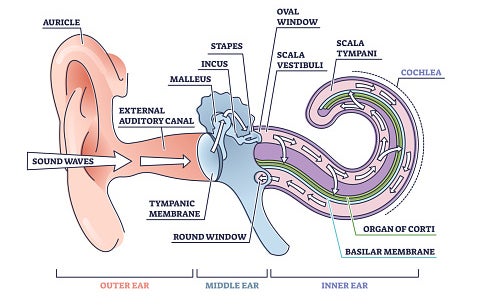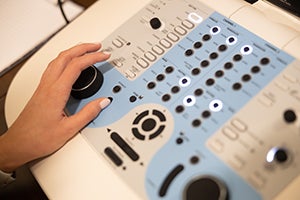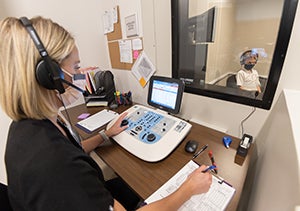Hearing Loss
Causes
The ear consists of three parts: the outer, middle and inner ear, including the auditory nerve and auditory system/pathway.

When a problem occurs in one or all of these parts, hearing loss can occur. These problems can be congenital or acquired, meaning — across patient populations — genetics may play a role in hearing loss as well as aging of one's auditory system.
Conditions that contribute to hearing loss:
- Chronic noise exposure
- Illnesses and injuries
- Ototoxic medications
Changes in hearing can occur suddenly or gradually.
Symptoms
Typical symptoms of hearing loss include but are not limited to the following:
- Muffled perception of speech
- Increasing difficulty understanding others (especially in situations where there’s a lot of background noise)
- Listening to television, radio or other auditory devices at a high volume
- Asking others to repeat themselves more often
- Withdrawing from conversations/certain social settings
- Talking loudly
Types
The three main types of hearing loss include conductive, mixed and sensorineural.
- A conductive hearing loss is when sound is hindered from getting through your outer and middle ear. This could be caused by an ear infection, a hole in the eardrum, head trauma, earwax, swimmer’s ear, etc. Typically, conductive hearing losses can be resolved by medicine or surgery; however, it can be permanent in some cases.
- A sensorineural hearing loss is when there is a problem with the inner ear or the auditory nerve. This is typicaly permanent, though in rare cases it can be treated and resolved.
- A mixed hearing loss encompasses both a conductive and sensorineural hearing loss.
Degrees
Degrees of hearing loss range from mild to profound, and different descriptors include the following: 
- Congenital versus Acquired
- Fluctuating versus Stable
- Gradual versus Sudden
- Pre-lingual versus Post-lingual
- Symmetrical versus Asymmetrical
- Unilateral versus Bilateral
When to Seek Medical Care
If you are experiencing any of the symptoms previously mentioned, it’s always a great idea to seek treatment through an ENT who will then do a full workup and refer you to an audiologist. The sooner you are tested and discuss a treatment route — the better! An audiologist will be able to answer your questions and address any concerns you have about moving forward with treatment (i.e. amplification).
 Diagnostics
Diagnostics
When attending an appointment with one of our ENTs, you should expect a full workup. You will then be referred to an in-office audiologist for a full battery of tests beginning with the outer portion of the ear, working in towards the inner portion of the ear/ hearing nerve.
- Otoscopy: a visual inspection of your external ear canals and ear drums.
- Pure tone thresholds: the “gold standard” diagnostic test used to identify the softest volume a person is able to hear specific frequencies; this provides a basis for not only the type of hearing loss but the degree and configuration as well
- Speech recognition: measures the softest volume you can hear, correctly comprehending two-syllable words
- Tympanometry: measures the movements of your eardrums by using positive and negative pressure to rule out a conductive hearing loss. Thereafter, you are taken into the booth where tone and words are tested.
- Word recognition: a person’s ability to correctly repeat words out-of-context at a volume above their threshold
Other tests may be added to the battery depending on certain findings and/or patient complaints.
Treatments
Hearing loss is a medical condition that requires treatment, which typically involves hearing aids. While hearing aids may seem intimidating and costly, being properly fitted by an audiologist is the suggested route of treatment. Hearing aids are not a one-size-fits-all method. These devices are programmed specifically for a person’s hearing loss, amplifying the specific frequencies you need while simultaneously reducing background noise. (Be cautious when you see advertising about “$99 hearing aids.” Those are typically amplifiers which are more of a one-size-fits-all option; they amplify everything, including background noise.)
There are other less costly assistive devices available, including FM systems, captioning, telephone amplifiers, portable sound amplifiers, text telephones, flashing and vibrating alarms, etc. However, these devices are not considered hearing aids.
With the FDA ruling of over-the-counter products (OTC) hearing aids, realize that these devices are intended only for adults with mild to moderate hearing losses. OTC hearing aids are a fantastic option for this specific demographic, especially in terms of accessibility and affordability. However, if you have a hearing loss that is greater than moderate, prescription hearing aids via an audiologist is the most appropriate course of action.
For profound hearning loss, cochlear implants are an option for some patients. WakeMed will refer patients for this procedure if approved.
Prevention
It is very important to wear hearing protection any time you are around loud noise. Whether it is a two-hour concert or an afternoon mowing the lawn, it is critical to protect your hearing. Exposure to very loud sounds has the potential to damage hearing over time, no matter how short the duration of that exposure. On some devices with headphone inputs, it is possible to check your device to ensure it is not exceeding the threshhold for safe sound exposure.
Outcomes for Hearing Loss that is Left Untreated
Untreated hearing loss has been linked to both psychological and social problems that can affect a person’s quality of life.
Children
- For children, untreated hearing loss can lead to impaired global development. According to the Better Hearing Institute (BHI), it is imperative for children to hear because poor hearing can affect their language competence, cognitive development, social and emotional well-being and academic achievement.
- Should a child or their family choose the route of joining the Deaf community, it is imperative that they are provided access to a natural sign language to increase their chances of attaining global language proficiency. This will promote their cognitive development, social and emotional well-being and more.
Adults
- Regardless of the type, degree or configuration of hearing loss, the consequences of untreated hearing loss in adults can lead to social isolation, depression, strained inter-personal relationships, increased challenges with work, etc. Physically, untreated hearing loss can reduce your mobility, increase your fall risk, and affect your alertness/awareness in serious situations (I.e. fire alarm, cars approach, etc.). While there isn’t a direct correlation, research shows a strong link between the degree or severity of hearing loss and the risk of developing dementia.